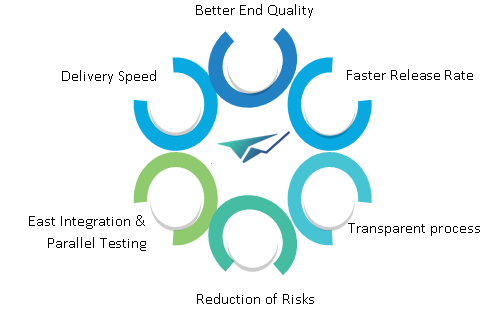

In the software world, continuous testing is the process of obtaining immediate feedback and the assessment of risks by executing automated tests on the software release candidates. Risk coverage is the primary objective and provides instant insights into the risk potential. Since continuous testing is integrated into the development process, it does not require a add on testing process at the end. One of the major principles that guide continuous testing is to test early, test often, test everywhere while automating. This is rather efficient than the traditional models of collaborative testing where software is passed between teams for testing purposes.
Continuous testing not only helps organizations roll out software faster but also helps to provide enhanced flexibility in terms of the testing process. This process covers everything from “shift left” (unit, component, coverage…) to “shift right” (monitoring/ APM, Testing in Production). To keep up and compete in a market where high-quality app experiences are the benchmarks, the approach of continuous testing needs to be instilled to become faster, more efficient, and effective.

Traditional Vs Continuous Testing
The old ways of testing majorly worked based on the hand-off process. First, the software requirement is defined and handed off to the development team. The development team creates and codes the software and further handoff to the QA team for testing. Finally, the QA team tests the software and verifies it for faults and sends it back to the development team or the deployment team. This process is long as the software is handed off from one team to another since the quality was given paramount importance.
The different approach of continuous testing ensures releases are faster and more often than the traditional methods. In the fast and dynamic process of continuous testing, undisrupted testing can be done continually. The codes are developed, tested, and delivered continuously resulting in faster software release cycles. The key components of continuous testing are test automation, continuous integration, and continuous delivery.
Also read:- Role of Video Analytics in Tomorrow’s Smart Cities
Major benefits of adopting continuous testing are:

The role of Continuous Integration & Continuous Delivery
Continuous Integration (CI)
It is considered as one of the most important parts of continuous testing process is the CD/CI pipeline. Continuous integration is the approach where codes are collected from developers in ongoing projects and placing it into a code repository. Continuous testing helps in the integration of codes by different developers can lead to bugs and issues. By automating your test execution each time, the code is integrated, it will help in allowing you to identify bugs early and fix them faster. This can help in finding bugs before they are released to production.
Continuous Delivery (CD)
Continuous delivery picks up where continuous integration ends. While CI is the process to build and test automatically, CD deploys all code changes in a build to the testing or staging environment. Continuous delivery is integral part continuous testing because testing of code is done before its deployment. The means that having a code ready to go without thorough testing is a waste of resource and should be immediately addressed.
Implementation of Continuous testing
We can see that continuous testing is an essential part of the testing process. In essence, it is recommended that continuous testing be performed at all stages of your CI/CD pipeline. Companies can set up test suites at every point of code changes, merges, or releases. This helps companies run tests at specific points rather than performing all the tests at once resulting in reduced time and effort. As such, this process does not hamper the quality of the test results but enhances it.
Continuous testing works best by using the most recent build in an isolated environment. methods such as containerization is an efficient way of code replication outside the main code repository. Certain tools are very helpful in making continuous testing even quicker as listed below
Some of the major Testing Tools for Continuous testing
There are companies that rely on sophisticated testing tools for continuous testing. These tools provide a platform for automated testing in a flexible manner. Some of the most used tools in Testing are:
Also read:- How AI & Data Science impact the Banking Industry
Continuous Testing aspect and its Implementation
Business systems presently mandate a quick-to-market strategy where Continuous Testing needs to be adopted. A dynamic shift in product launches makes legacy methods of testing a hindrance to obtaining immediate feedback. ‘Extreme Automation’ is what can solve the puzzle of unexpected risks arising towards the end of delivery.
Various aspects of Continuous Testing include:
Define Tests Early
Behaviour-driven development (BDD), acceptance test-driven development (ATDD), and model-based testing using tools should be used so that all requirements are documented and communicated. Test cases need to be clearly defined and test scripts created on an ongoing basis, to enable continuous testing of the system at all stages of production.
Optimize Testing Processes and Test Coverage
An effective automation strategy for continuous testing is the practice of selecting the right tests that provide the test coverage with the fewest number of test cases.
The first step here is optimizing the test scope by understanding all integrations involved in critical user workflows—including the technologies in the applications (web, mobile, API, etc.).
Analyze test cases for their quality, level of detail, and the greatest level of test coverage and design a Test suite to provide the maximum amount of coverage with the fewest number of test cases to increase both quality and velocity. The suite should be evaluated continually to de-scope tests that are no longer needed and add new tests based on new features.
Shift-Left-Right Testing
Shift Left helps in identifying testing requirements right from the project planning and requirements specification phase. Identify the estimated time and effort to complete the testing cycle and avoid duplication of tasks. Companies can adopt continuing to test by adding early testing for functionality, API, Integration, usability, performance, security, and accessibility resulting in an increase in quality and decrease in long test cycles while reducing the possibility of defect leakages to production.
The key aspect is that Shifting Right is all about leveraging the insights and usage of real customers and access to production data to test effectively and monitoring system/user behavior.
Adopt techniques including release validation, chaos testing, canary testing, and application monitoring.
Provide Complete Test Environments
The ability to provide a virtualized test environment is critical to achieving continuous testing. Eliminate blocks and reduce wait times by providing complete test environments on-demand, with dev-friendly tools (like code, CI/CD integrations, supported open source). These environments should include test data on demand to ensure that teams can perform comprehensive tests with production-like data. These environments should be transient; ready on demand, decommissioned after use.
Get the Right Test Data
The inability to get robust test data causes significant delays in many application release cycles. To accurately test new functionality, test data should be as close as possible to what the application will encounter in production. If the test data lacks certain real-world characteristics (i.e., actual fields, data specifications, negative scenarios, etc.), the tests are unlikely to find many potential issues or break the application where there are weak points. Understanding data models to extract the right data is a special skill in and of itself.
Also read:- 3 Use cases of Image mining and Text mining in 2021
Conclusion
Continuous testing is very effective and beneficial in more ways than one, but it can be also a challenging task to take up. Organizations should ensure to have a well-thought-out plan before incorporating this into their testing procedure. They can strategize around each team on how they can build it into their procedures to keep the testing flow seamless throughout the development process. This will require various teams working together to create a holistic testing approach, but the results are well worth the effort. For the best solutions in testing automation visit, Apexon.com